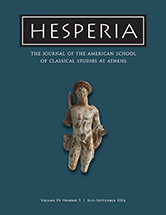Hesperia 93.3 Now Online!

We are pleased to announce the publication of Hesperia 93.3! Topics in this issue include the publication of terracotta figurines from Corinth, a look at the development of lead-glazed pottery in the Mediterranean, and a study detailing events at the American excavations at Sardis during the Greek-Turkish War.
Subscribers can read the issue online at Project MUSE, which now hosts current issues of Hesperia as well as an archive of past volumes dating to 2002. Hesperia remains on JSTOR as part of their Arts and Sciences II package, with the usual three-year moving wall. Additionally, all issues of Hesperia from 2011 and earlier are available as Open Access on our website. The printed version will be mailed shortly.
Terracotta Figurines from Drain 1971-1 in the Forum Southwest at Corinth, by Elizabeth Pemberton, focuses on Drain 1971-1, in the area of the later Roman Forum at Corinth, which produced an important group of terracotta figurines. These figurines show a great variety in style and type: some (for example, kore figures, banqueters, doves, a dog, and a snake stele) are typically votive, but others may have been fashioned for different purposes. The possible functions and primary contexts of these figurines are carefully considered along with the nature of the Drain deposit. A date at the end of the 4th century BCE provides an important terminus ante quem for the figurines.
The Emergence of Lead-Glazed Pottery in the Late Hellenistic and Roman Mediterranean: New Investigations at Mytilene, Athens, and Ostia, by Florence Liard, Miguel John Versluys, and Ayed Ben Amara, explores the circumstances and chronology of the emergence of lead-glazed pottery in the Late Hellenistic and Roman Mediterranean, a topic that remains heavily debated. This article presents a multidisciplinary discussion of pottery provenance and glazing technology based on the analysis of 94 samples from three sites: Mytilene, Athens, and Ostia. Through a critical review of published data and comparisons with other glazed ceramics, the emergence of lead-glazed pottery against the background of a highly interconnected, “global” world is discussed. As a result, the authors argue that mainland Greece played an important but hitherto unrecognized role in this development.
American and Greek Archaeologists at Sardis during a Fateful Year, by Theodore C. Eliopoulos, publishes for the first time a notebook and a report by the Greek archaeologist Nikolaos Laskaris. Both documents date to the spring of 1922, when Laskaris was supervising the American excavations at Sardis. Combined with additional archival material presented here, Laskaris’s writings contribute to our knowledge of Sardian archaeology, and at the same time illuminate the dire historical circumstances of the ongoing Greek-Turkish War that surrounded the campaign of that year.
Click here to subscribe to Hesperia. In addition to receiving printed issues and online access to Hesperia, subscribers also receive complimentary online access to Hesperia Supplements, and Agora and Corinth volumes.
Hesperia welcomes submissions from scholars working on all aspects of Greek material culture, including archaeology, art, architecture, history, epigraphy, and related studies. Further information about the journal, including instructions for preparing manuscripts for submission, can be found on our website.
The Friends of Hesperia was founded in 2014 to help fund the journal's growth in all its manifestations. We invite you to become a member today and help support one of the most preeminent journals in the field of Mediterranean archaeology.